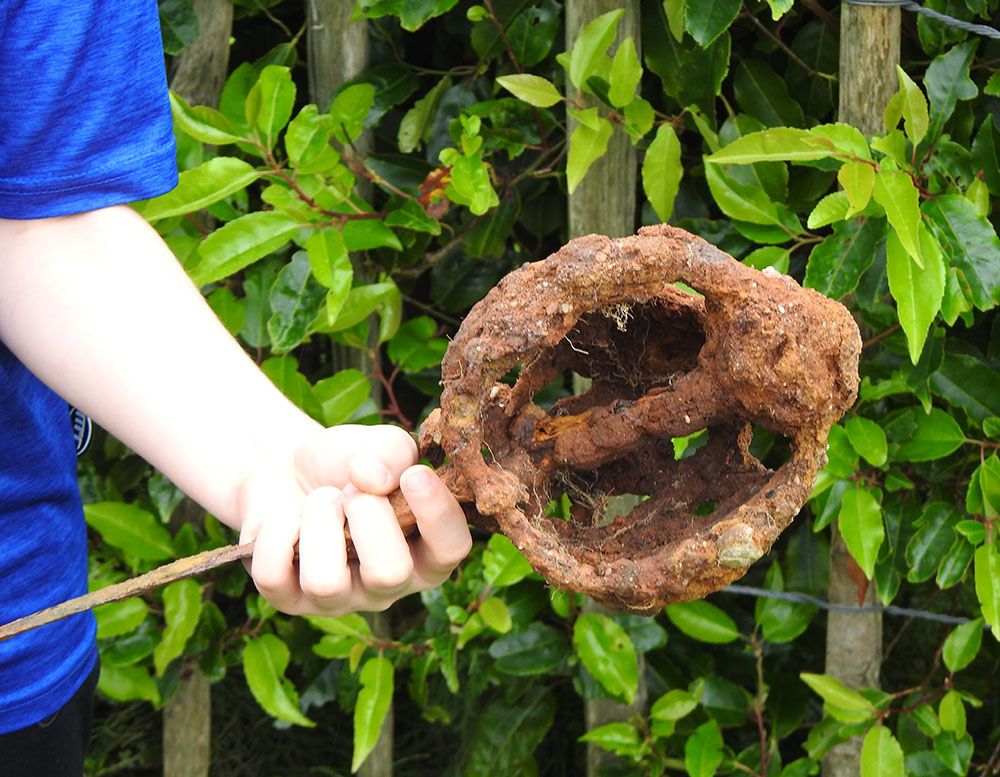Using a Metal Detector, 10-Year-Old Boy Finds Centuries-Old Sword in Northern Ireland
Fionntan Hughes had just received the device for his birthday
:focal(500x376:501x377)/https://tf-cmsv2-smithsonianmag-media.s3.amazonaws.com/filer/cb/23/cb23eb85-cca2-49c7-bae5-95cdc323705d/2020_aug22_rustysword.jpg)
In July, ten-year-old Fionntan Hughes got a metal detector for his birthday. The first time he took it out for a spin, Hughes found a centuries-old sword buried about a foot underground, Eimear Flanagan reports for BBC News.
Fionntan, his father and his cousin were using the metal detector on the banks of the River Blackwater near his home in Northern Ireland when they found the sword on their third hit. They dug up the large, mud-covered object, brought it home and washed it off with a garden hose, Fionntan tells Aftenposten Junior. That revealed it was half of a rusted, old sword with an ornate pommel.
“I felt excited,” Fionntan tells BBC Newsline’s Cormac Campbell. “because it was a sword and it was just here, and I didn’t really expect anything too big.”
The sword’s ornate handle is its most identifiable feature, but antiques experts Mark and David Hawkins tell BBC News that the sword is difficult to identify from photographs because the rust may be exaggerating its size. But it looks like an English basket-hilted broadsword that was introduced between 1610 to 1640.
It seems to have a plum pudding pommel, which is “typical of the early types,” the Hawkins tell BBC News, but because some designs were used by English officers for more than a century, they suspect this sword is from the late 1600s or early 1700s.

Most metal detectorists are not so lucky, but between 1997 and 2016, amateur history fans found about 1 million archaeological discoveries in the United Kingdom alone.
In 1992, a man looking for his lost hammer happened upon a 60-pound hoard of Roman gold and silver artifacts. In 2016, another metal detectorist found a hoard of Viking artifacts. A 2019 discovery showed evidence of 11th-century tax evasion, and this June, a Welsh man found a lead ingot inscribed with Latin.
The U.K.’s Treasure Act of 1996 requires those who discover caches of buried treasure to report their finds to the local coroner’s office, who will then notify local authorities. Last year, four men received sentences of between five and ten years in prison because they didn’t report the Viking artifacts they found in 2015, Lateshia Beachum reported for the Washington Post at the time.
After Fionntan and his family realized he had found a sword, his father Paul Hughes notified the National Museums Northern Ireland archaeology curator Greer Ramsey. Ramsey is now in the process of identifying the sword in more detail, per BBC News.
"The last thing I want is for it to be left rusting away in my garage," Hughes tells BBC News, adding that he worries the sword is “deteriorating by the day.”
The family hopes to give it to a museum for preservation and eventual display. But the Covid-19 pandemic has made it challenging to hand the sword off to a museum expert, according to Aftenposten Junior.
The riverbank where Fionntan found the sword was dredged in the 1980s, which would have displaced sediment and objects at the bottom of the river, reports BBC Newsline. Because of that, the family believes there may be more interesting artifacts buried nearby. And Fionntan tells BBC News that he’s looking forward to going metal detecting again.